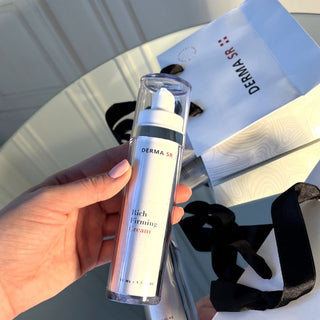First of all - what are mineral protective filters?
Mineral sunscreens have SPF that manually block UV rays by creating a barrier on the skin. They can be seen as a ray-reflecting "mirror" - the rays, in contact with SPF, bounce off, protecting the skin from damage. Such protective filters are zinc oxide and titanium dioxide.
What are chemical sunscreens?
Chemical sunscreens such as oxybenzone, octinoxate, octisalate, and avobenzone work by absorbing UV rays, causing a chemical reaction that then converts the UV into heat. Chemical sunscreens are the most commonly used sunscreens because they blend more easily with the skin without leaving a white mask.
So, in order to weigh your options, let's look at the pros and cons of mineral SPFs.
Pro: Safest for the skin and the environment.
Currently, zinc oxide and titanium dioxide are the only two ingredients recognized by the Environmental Working Group as safe for use and effective in protecting the skin from UV damage. And as long as the minerals aren't nano-sized (read: not broken down into smaller pieces), they're considered environmentally safe because studies show they don't cause coral bleaching or affect marine life.
Con: Many leave a white cast on the skin.
Because mineral protective filters are thicker, they can make the skin visually white. This is especially noticeable in the higher Fitzpatrick skin type. Therefore, many choose chemical filters on a daily basis, because they do not make the skin dry. To combat this problem, Suntribe Sunscreens have been added with a brownish tint to help the products blend better with the skin. Therefore, the skin no longer looks as white as it would be with other mineral protection products
Pro: suitable for allergic, sensitive, reactive skin.
Zinc oxide is arguably the most skin-soothing of all active sunscreen ingredients. It can even help sensitive and acne prone skin as it is non-comedogenic (doesn't clog pores).
And now let's look at the main pros and cons of chemical sunscreens.
Con: Some have been shown to cause coral bleaching.
There's a reason some countries, and even states in the US, have banned oxybenzone and octinoxate: they've been shown to cause coral bleaching (or brightening of coral's normal bright colors) and pose a significant threat to marine life, as coral is home to thousands of marine animals.
Pros: Easier to formulate and more attractive in appearance.
These ingredients tend to be thinner, easier to spread, and work better with other skin care ingredients. This is why chemical filters are so widely used in sunscreens.
Con: penetrates deeper into the skin and can be allergenic.
Research continues to show that many of these ingredients—especially oxybenzone and avobenzone—are absorbed into the bloodstream even after a single use. Researchers don't yet agree on what they do when they're absorbed, but so far theories have suggested that they can mutate and become carcinogenic when exposed to the sun, alter our hormonal systems and cause allergies.
Experts agree that you should try to avoid sunscreens, especially oxybenzone and octinoxate. They are significant skin allergens and have been shown to have some estrogen-mimicking effects on the body.
So which sunscreen to use?
The best sunscreen is the one that you put on. After all, the most important reason we use it is to protect our skin from the harmful effects of the Sun and skin cancer.
However, due to the absorption and environmental concerns of chemical sunscreens, we recommend mineral filters. Of course, there are not so many of them, they can be more difficult to apply, but their effect (both on the skin and on the environment) makes them the best alternative - especially if you have sensitive skin and if you want a product that is more resistant to sweat and water.
Check out Suntribe sunscreens in our webpage- they are 100% mineral filters that would be suitable even for the most irritated skin.

